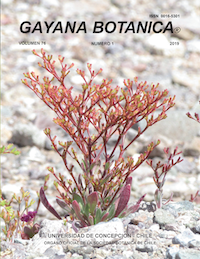Genetic diversity and structure of the vulnerable species Prosopis chilensis (Molina) Stuntz in the Coquimbo Region, Chile
DOI:
https://doi.org/10.4067/S0717-66432019000100091Keywords:
arid zones, biodiversity, microsatellites, transverse valleys, spatial principal component analysis (sPCA)Abstract
The Prosopis genus (Mimosoideae, Leguminosae) constitutes an important genetic resource for arid and semiarid environments. Prosopis chilensis (Molina) Stuntz is a multipurpose species native to South America, which displays high phenotypic variability. In Chile, this species grows in the semiarid region, along river beds of the transverse valleys. We studied the genetic diversity and population genetic structure of P. chilensis across the three transverse valleys of the Coquimbo Region (29°-32°S) by analysing the genetic diversity of 182 individuals with four nuclear and one chloroplast microsatellite markers. Using a spatial principal component analysis (sPCA), we detected a clear hierarchical genetic structure. This analysis revealed the existence of seven distinct genetic clusters throughout the whole studied region. None of the genetic clusters detected overlapped between valleys. This suggests that the mountain ridges separating the three transverse valleys may have exerted a barrier effect. However, while significant, population differentiation was low and most of the genetic variation was found within clusters. These results suggest that high gene flow might be counteracting and blurring the effects of the structuring factors. This is the first study of genetic population of P. chilensis in Chile and the genetic data obtained may be valuable for the conservation of this vulnerable, multipurpose tree species.
Downloads
Metrics
Downloads
Published
How to Cite
Issue
Section
License
Authors who publish with this journal agree to the following terms:
- Authors retain copyright and grant the journal right of first publication.
- The articles in this journal are published under Creative Commons Attribution-NonCommercial 4.0 International License that allows others to share the work with an acknowledgement of the work's authorship and initial publication in this journal.
- Authors are permitted and encouraged to post their work online (e.g., in institutional repositories, on their website or ResearchGate) prior to and during the submission process, as it can lead to productive exchanges, as well as earlier and greater citation of published work (SeeThe Effect of Open Access).













